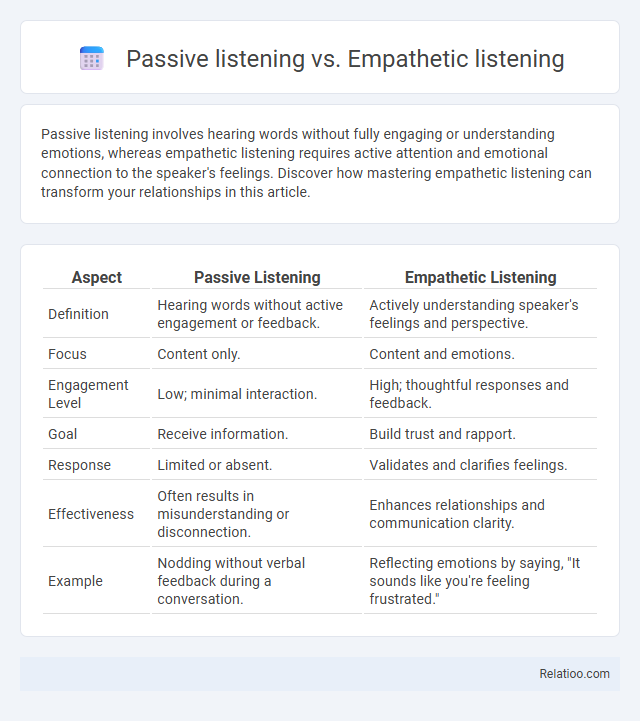Passive listening involves hearing words without fully engaging or understanding emotions, whereas empathetic listening requires active attention and emotional connection to the speaker's feelings. Discover how mastering empathetic listening can transform your relationships in this article.
Table of Comparison
| Aspect | Passive Listening | Empathetic Listening |
|---|---|---|
| Definition | Hearing words without active engagement or feedback. | Actively understanding speaker's feelings and perspective. |
| Focus | Content only. | Content and emotions. |
| Engagement Level | Low; minimal interaction. | High; thoughtful responses and feedback. |
| Goal | Receive information. | Build trust and rapport. |
| Response | Limited or absent. | Validates and clarifies feelings. |
| Effectiveness | Often results in misunderstanding or disconnection. | Enhances relationships and communication clarity. |
| Example | Nodding without verbal feedback during a conversation. | Reflecting emotions by saying, "It sounds like you're feeling frustrated." |
Understanding Passive Listening
Passive listening involves hearing words without actively engaging or interpreting the message, often leading to minimal comprehension or retention. In contrast, empathetic listening requires fully focusing on the speaker's emotions and perspectives to foster deeper connection and understanding. Emphasizing understanding, passive listening lacks intentional feedback or clarification, resulting in limited awareness of the speaker's true intent or feelings.
Defining Empathetic Listening
Empathetic listening involves fully understanding and sharing the speaker's emotions, going beyond merely hearing words, unlike passive listening, which is characterized by minimal engagement and attention. Passive listening allows information to be received without active response or emotional connection, whereas empathetic listening requires active involvement, interpreting feelings, and responding with compassion. This deep, emotionally attuned approach enhances communication effectiveness and fosters trust and rapport between interlocutors.
Key Differences Between Passive and Empathetic Listening
Passive listening involves hearing words without fully engaging or providing feedback, often leading to missing emotional cues and deeper understanding. Empathetic listening requires actively tuning into the speaker's feelings and perspectives, demonstrating genuine concern and creating a connection that fosters trust and clarity. Your ability to distinguish between these listening styles can significantly impact communication effectiveness and relationship building.
Benefits of Empathetic Listening
Empathetic listening enhances your ability to understand emotions and perspectives, fostering stronger connections and trust in communication. Unlike passive listening, which simply absorbs words without engagement, empathetic listening actively processes feelings, resulting in improved conflict resolution and emotional support. This approach benefits relationships by creating a safe environment where individuals feel heard and valued.
Drawbacks of Passive Listening
Passive listening often leads to misunderstandings and miscommunication because the listener fails to actively engage or provide feedback. Unlike empathetic listening, which involves understanding and responding to the speaker's emotions, passive listening can cause important emotional cues to be missed. This lack of engagement may result in weakened relationships and reduced trust between individuals.
Real-Life Examples of Listening Styles
Passive listening involves hearing words without engaging, such as a student merely hearing a lecture without taking notes or asking questions. Empathetic listening requires understanding the speaker's emotions, exemplified by a friend consoling another during a difficult time, fully focusing on their feelings and responding supportively. Real-life examples highlight passive listening during routine meetings with minimal interaction, reflective listening in counseling sessions where understanding is critical, and active listening in collaborative team environments emphasizing feedback and clarification.
The Role of Emotional Intelligence in Listening
Emotional intelligence plays a crucial role in differentiating passive listening, empathetic listening, and active listening by enhancing your ability to recognize and respond to emotions conveyed in conversations. Passive listening involves hearing words without emotional engagement, while empathetic listening requires understanding and validating the speaker's feelings through emotional awareness. Active listening combines emotional intelligence with attentiveness to ensure meaningful feedback and deeper connection during communication.
How Empathetic Listening Improves Communication
Empathetic listening enhances communication by actively engaging with the speaker's emotions and perspectives, fostering deeper understanding and trust. Unlike passive listening, which involves merely hearing words without processing meaning, empathetic listening requires attention to tone, body language, and feelings, leading to more meaningful and effective interactions. This approach reduces misunderstandings and promotes collaborative problem-solving by validating the speaker's experience and encouraging open dialogue.
Strategies to Develop Empathetic Listening Skills
Empathetic listening involves fully engaging with the speaker's emotions and perspectives, unlike passive listening which only requires hearing words without deep connection. Strategies to develop empathetic listening skills include maintaining eye contact, reflecting emotions by paraphrasing, and asking open-ended questions to encourage deeper sharing. Practicing mindfulness and eliminating distractions further enhance the ability to understand and respond to the speaker's feelings effectively.
Choosing the Right Listening Approach
Choosing the right listening approach depends on your communication goals and the context of the interaction. Passive listening involves hearing without engaging, suitable for absorbing information, while empathetic listening requires you to actively understand and connect with the speaker's emotions, essential for building trust and rapport. Your ability to distinguish between passive, empathetic, and active listening ensures effective responses and stronger interpersonal relationships.

Infographic: Passive listening vs Empathetic listening
 relatioo.com
relatioo.com